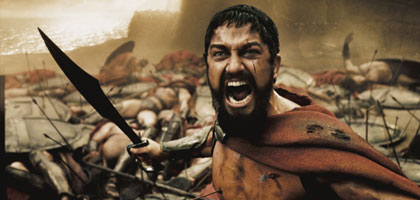Primary navigation


A technical masterpiece, '300' brings Frank Miller's comic-book rendering of the Battle of Thermopylae to the screen complete with blood-spatters and a wall of bristling beefcake. It's a marvel, says Andrew Osmond
Critics and viewers may be split over the merits of the historical epic 300,but its technical achievement is beyond question. The latest slice of comic-book hyperreality to be brought to the screen, 300 was shot in a converted railway shed in Montreal on soundstages and copious greenscreens. Seen from that perspective, the film's presentation of the cities and battlegrounds of ancient Greece can only be considered a marvel, vividly rendered through a digitised expressionist palette: the stormy blackness of the overture, the sunlit white colonnades of the Spartan city, the golden coast where the last battle ends in noble sacrifice.
But if 300 represents an evolution in 'virtual' cinema, then at the same time it tells a story that transports us back to the violent roots of western civilisation. Directed by Zack Snyder, following the success of his lively but redundant zombie remake Dawn of the Dead (2004), the film is a luridly mythologised account of the 5th-century BC Battle of Thermopylae, which pitted the tiny Spartan force of the title, led by King Leonidas (Gerard Butler), against thousands of Asian invaders. 300 is a companion piece to the hardboiled fantasy Sin City (2005), also faithfully based on a graphic novel by writer-artist Frank Miller. Like Sin City, 300 is excessively (though not as shockingly) violent, full of a hard machismo that is shamelessly sentimentalised. But in place of the mostly monochrome noir of Robert Rodriguez's film, 300'ssoft-focus vistas draw on the fantasy oil-paintings of such artists as Frank Frazetta and, more obviously, on Peter Jackson's Lord of the Rings.
Through these landscapes march the muscled 300, decked out in scarlet cloaks, steel greaves and brown jockstraps (all faithful to Miller's comic, though it also sometimes has them in the heroic nude). The surplus of beefcake is an amusing balance of sorts to the gun-toting, fetish-doll whores in Sin City andinvites enough knowing chuckles from modern audiences without the need for camp winks and nudges. Leonidas casually dismisses his Athenian "boy-lover" allies, but the tyrannical Persian emperor Xerxes, played by a deep-voiced Rodrigo Santoro festooned with metal collars and bangles, advertises his sexual ambiguity more openly as the camera repeatedly closes in on his sensually mobile lips. (Less effective is a woeful orgy scene in which Xerxes seduces the hunchbacked Spartan traitor Ephialtes.) The Spartans' unselfconsciousness is used to broad comic effect in a treasurable scene that shows them after their first successful battle standing knee-deep in enemy corpses and casually running the wounded through as they groan and scream.
Like Sin City, 300 serves up Miller's hardboiled strip rare, highlighting rather than softening his more irresponsible pictures. Indeed 300 opens with what feels like Snyder's declaration that he can out-Miller Miller himself. In a departure from the comic, the first shot shows infant skulls at the base of a cliff. We see the baby Leonidas being coldly examined to determine whether he's physically fit for Spartan society or must be 'discarded'. Contrary to what one might assume, this isn't the basis for a sarcastic comment on action-film heroism in the style of the quasi-fascist future of Paul Verhoeven's Starship Troopers. Instead the rough eugenics programme is left to stand unchallenged by frequent assertions that the militarised Spartan state is the only effective defence of reason, justice and the ancient west against Asian hordes who can crucify the population of an entire village on a single tree, a gruesome image that recalls Mel Gibson's Apocalypto.
As of writing, there are reports of Iranian outrage at the film's unflattering portrait of Persian culture and supposed demonising of ancient eastern civilisation. (For the record, Miller says his interest in Thermopylae was sparked by the 1961 film The 300 Spartans,directed by Rudolph Maté.) Yet within 300 itself all accusations of one-sidedness are deflected by the framing of the main action within the voiceover of Homeric storyteller Dilios, played by a one-eyed David Wenham. The point and pleasureof Dilios' story, in which Wenham infuses life into what Will Brooker (author of the comics critique Batman Unmasked) calls Miller's "flat, efficient shorthand" prose, is that the film's narrative is tribal propaganda. Sparta's own priests are denounced as "inbred swine" with "souls as black as hell" and presented as leprous, slobbering Gollums on a windblown black crag before the film gets around to insulting the Persians. Dilios is shown in the story accompanying Leonidas to battle, but he's explicitly absent from the climactic events that we nevertheless hear him describing.
The original Miller strip was short (88 double-size pages) and could be enjoyed as an exercise in graphic and narrative form. A film is a different matter, however, and Snyder does exceptionally well in the early scenes, which improve on the comic and show an intensity of mythic vision and atmospherics that only Guillermo del Toro's Pan's Labyrinth has matched. A flashback to Leonidas' testing as a youth reveals the boy battling a flame-eyed wolf in the snow, the sabre-toothed beast as frightening as any Lord of the Rings monsterasits silhouette materialises out of inky shadow. Yet there's also a tender bedroom scene (not in the strip) between Leonidas and his wife Queen Gorgo (Lena Headey) that works equally well in the graphically strong tableaux style. Butler conveys both Leonidas' oaken regality and warmth in and out of battle, addressing his surviving young men as "children" just before their certain death. Headey has a similarly strong presence ("Only Spartan women give birth to real men") in a much less satisfactory role.
But the battle scenes don't sustain the film so well. Much of the action shows individual Spartan heroes carving their way through a series of foes, their movements flowing between normal speed and slow-motion as the screen fills with the spattery explosions of blood that characterise the strip. (According to the making-of book, "authentic" blood-spatters were scanned from the graphic novel then incorporated into the screen image.) There are moments of visceral power - not least in the first engagement, in which we feel the Spartan phalanx forced backwards by the weight of the thousands-strong enemy - but before long the combat becomes remorselessly one-note and distanced, making one miss the funnier exaggerated violence of Sin City and Tarantino's Kill Bill. The CGI elephants and orc-like giants in the enemy ranks make 300 too reminiscent of Lord of the Rings, despite Snyder's relish for beheadings and flying limbs.
Unlike in the strip, these battle scenes are interspersed with a subplot in which Queen Gorgo struggles to raise support for her husband from the Spartan council, sacrificing her body in the process. But the structure is weak, not least because Gorgo's actions are irrelevant to the main story since the ending makes it clear that it is Dilios who secures Leonidas' posthumous victory in an upbeat epilogue à la Braveheart. Less satisfactory than Sin City, 300 is particularly frustrating because of the promise of its first act. Yet like Leonidas, the film has the prospect of a lasting legacy following its surprise smash success at the American box office.